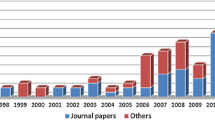We study the problem of allocating berth space for vessels in container terminals, which is referred to as the berth allocation planning problem. We solve the static berth allocation planning problem as a rectangle packing problem with release time constraints, using a local search algorithm that employs the concept of sequence pair to define the neighborhood structure. We embed this approach in a real time scheduling system to address the berth allocation planning problem in a dynamic environment. We address the issues of vessel allocation to the terminal (thus affecting the overall berth utilization), choice of planning time window (how long to plan ahead in the dynamic environment), and the choice of objective used in the berthing algorithm (e.g., should we focus on minimizing vessels’ waiting time or maximizing berth utilization?). In a moderate load setting, extensive simulation results show that the proposed berthing system is able to allocate space to most of the calling vessels upon arrival, with the majority of them allocated the preferred berthing location. In a heavy load setting, we need to balance the concerns of throughput with acceptable waiting time experienced by vessels. We show that, surprisingly, these can be handled by deliberately delaying berthing of vessels in order to achieve higher throughput in the berthing system.
Access this chapter
Tax calculation will be finalised at checkout
Purchases are for personal use only
Preview
Unable to display preview. Download preview PDF.
Similar content being viewed by others
References
R.K. Ahuja, T.L. Magnanti, and J.B. Orlin (1993). Network Flows: Theory, Algorithms, and Applications. Prentice-Hall, Englewood Cliffs, NJ.
F. Barahona and R. Anbil (2000). The volume algorithm: producing primal solutions using a subgradient method, Mathematical Programming, 87, 385-399.
G.G. Brown, S. Lawphongpanich, and K.P. Thurman (1994). Optimizing ship berthing, Naval Research Logistics, 41, 1-15.
C.Y. Chen and T.W. Hsieh (1999). A time-space network model for the berth allocation problem, Presented at the 19th IFIP TC7 Conference on System Modelling and Optimization.
L.W. Chen (1998). Optimisation problem in a container port, M.Sc. Research Report, SoC, NUS.
J.T. Chia, H.C. Lau, and A. Lim (1999). Ant colony optimization for the ship berthing problem, in P.S. Thiagarajan, R. Yap (Eds.): ASIAN’99, LNCS 1742, pp. 359-370.
J.G. Dai and W. Lin (2005). Maximum pressure policies in stochastic processing networks, Operations Research, 53, 197-218.
A.V. Fishkin, K. Jansen and L. Porkolab (2001). On minimizing average weighted completion time: A PTAS for scheduling general multiprocessor tasks, in Proceedings 13th International Symposium on Fundamentals of Computation Theory (FCT’01), Rusins Freivalds (Ed.), Riga, LNCS 2138, Springer Verlag, pp. 495-507.
Y.P. Guan and R.K. Cheung (2004). The berth allocation problem: models and solution methods, OR Spectrum, 26, 75-92.
Y.P. Guan, W.Q. Xiao, R.K. Cheung, and C.-L. Li (2002). A multiprocessor task scheduling model for berth allocation: heuristic and worst case analysis, Operations Research Letters, 30, 343-350.
S. Imahori, M. Yagiura, and T. Ibaraki (2003). Local search algorithms for the rectangle packing problem with general spatial costs, Mathematical Programming Series B, 97, 543-569.
A. Imai, E. Nishimura, and S. Papadimitriou (2001). The dynamic berth allocation problem for a container port, Transportation Research Part B, 35, 401-417.
A. Imai, E. Nishimura, and S. Papadimitriou (2003). Berth allocation with service priority, Transportation Research Part B, 37, 437-457.
K.H. Kim and K.C. Moon (2003). Berth scheduling by simulated annealing, Transportation Research Part B, 37, 541-560.
C.L. Li, X. Cai, and C.Y. Lee (1998). Scheduling with multiple-job-on-one-processor pattern, IIE Transactions, 30, 433-446.
A. Lim (1998). On the ship berthing problem, Operations Research Letters, 22(2-3), 105-110.
S.N. Loh (1996), The Quadratic Assignment Problem and its Generalization to the Berth Allocation Problem, Honours Years Project Report, DISCS, NUS.
K.C. Moon (2000). A Mathematical Model and a Heuristic Algorithm for Berth Planning, Unpublished Thesis. Pusan National University.
H. Murata, K. Fujiyoshi, S. Nakatake, and Y. Kajitani (1996). VLSI module placement based on rectangle packing by the sequence pair, IEEE Transactions on Computer Aided Design of Integrated Circuits and Systems, 15-12, 1518-1524.
H. Murata, K. Fujiyoshi, and M. Kaneko (1998). VLSI/PCB placement with obstacles based on sequence pair, IEEE Transactions on Computer Aided Design of Integrated Circuits and Systems, 17, 60-68.
Y.M. Park and K.H. Kim (2003). A scheduling method for Berth and Quay cranes, OR Spectrum, 25, 1-23.
D. Steenken, S. Voss, and R. Stahlbock (2004). Container terminal operation and operations research a classification and literature review, OR Spectrum, 26, 3-49.
X. Tang, R. Tian, and D.F. Wong (2000). Fast evaluation of sequence pair in block placement by longest common subsequence computation, in Proceedings of the Conference on Design, Automation and Test in Europe, pp. 106-111.
C.J. Tong, H.C. Lau, A. Lim (1999). Ant Colony Optimization for the ship Berthing problem, Asian Computing Science Conference (ASIAN), pp. 359-370.
Author information
Authors and Affiliations
Editor information
Editors and Affiliations
Rights and permissions
Copyright information
© 2008 Springer Science+Business Media, LLC
About this chapter
Cite this chapter
Dai, J., Lin, W., Moorthy, R., Teo, CP. (2008). Berth Allocation Planning Optimization in Container Terminals. In: Tang, C.S., Teo, CP., Wei, KK. (eds) Supply Chain Analysis. International Series In Operations Research & Mana, vol 119. Springer, Boston, MA. https://doi.org/10.1007/978-0-387-75240-2_4
Download citation
DOI: https://doi.org/10.1007/978-0-387-75240-2_4
Publisher Name: Springer, Boston, MA
Print ISBN: 978-0-387-75239-6
Online ISBN: 978-0-387-75240-2
eBook Packages: Business and EconomicsBusiness and Management (R0)




